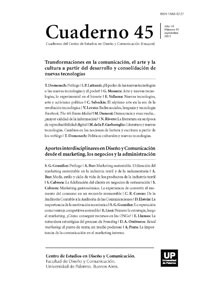Moda, estilo y ciclo de vida de los productos de la industria textil
Abstract
Fashion reflects the taste, the dominant values and views of a certain historical period. When people think about fashion, generally, imagine a fantasy world made up of designers, models and attractive clothing. Actually, fashion is not just a dress, but applies to any product or service consumer, for example, cars, music, furniture, magazines or tourist destinations. If we consider fashion from the clothing point of view, we found that it has not only a sociocultural dimension found but also an economic one. Regarding the latter, we note that the fashion marketing functions is to determine which products will sell, to whom, at what prices, how they will communicate and what will be their distribution channels. Often, it arises a confusion between fashion and style. Fashion refers to a product that becomes popular for a period of time and in a certain place. In style, this refers to the features and details that differentiate one product from others. Within the same style can be many variations in its creation: we are in presence of the designs. There are always many more design styles. When a style becomes popular becomes fashionable.
The products of fashion clothing, like any product, can apply the life cycle model . This model assumes that products are introduced to competitive markets go through a predictable cycle time. Each stage receives a specific name: introduction, growth, maturity and decline. Knowing the stage of the cycle which is the fashion product enables marketers to design the most effective strategy to market, which is particularly relevant in highly competitive markets in which the textile industry must act.
References
Barthes, R. (1978). Sistema de la moda. Barcelona: Gustavo Gili.
Beaton, C. (1990). El espejo de la moda. Barcelona: Parsifal.
Grünfeld, M. (2005). Reflexiones sobre la moda. Trabajo Final en la Maestría “Generación y Análisis de Información Estadística”. Universidad de Tres de Febrero (UNTREF), Argentina.
(1997). Marketing de la moda. Buenos Aires: Universo.
König, R. (1972). Sociología de la moda. Barcelona: Redondo.
Kotler, P. y Keller, K. L. (2006). Dirección de Marketing (12ª ed.). México: Prentice Hall.
Lambin, J. (1995). Marketing estratégico (3ª ed.). Madrid: McGraw-Hill.
Levitt, T. (1965). Exploit the product life cycle. Harvard Business Review, 43 (6), 81-94.
Martínez Caballero, E., Vázquez Casco, A. (2006). Marketing de la moda. Madrid: Pirámide.
Piñuel Raigada, J. L. (1992). La moda, o el aprendizaje de la integración por el cambio. Revista Española de Investigaciones Sociales (Rais), 57, 227-244.
Poiret P. (1930). En habillant l’epoque. París: Grasset.
Sandhusen, L. R. (2002). Mercadotecnia. México: Compañía Editorial Continental.
Saulquin, S. (1999). La moda, después. Buenos Aires: ISM.
(1998). La moda en la Argentina. Buenos Aires: Emecé.
Sproles, G. & Burns, L. (1994). Changing Appearances: Understanding Dress in Contemporary Society. New York: Fairchild Publications.
Sproles, G. (1985). Behavioral science theories of fashion. In Solomon, M. R. (Ed.), The psychology of fashion. Massachusetts: Lexington Books.
Wilensky, A. (2006). Marketing estratégico (8ª ed.). Buenos Aires: Temas.
Los autores/as que publiquen en esta revista ceden los derechos de autor y de publicación a "Cuadernos del Centro de Estudios de Diseño y Comunicación", Aceptando el registro de su trabajo bajo una licencia de atribución de Creative Commons, que permite a terceros utilizar lo publicado siempre que de el crédito pertinente a los autores y a esta revista.


